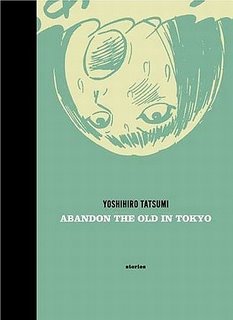Graphic Lit: Tatsumi & Delisle

“ABANDON THE OLD IN TOKYO”
stories by Yoshihiro Tatsumi
Drawn and Quarterly, 224 pages, $19.95.
“SHENZHEN: A TRAVELOGUE FROM CHINA”
by Guy Delisle, Drawn and Quarterly
152 pages, $19.95.
Saying Yoshihiro Tatsumi’s stories are bleak is sort of like saying water is wet. It also misses the point.
Most of the Japanese comics that have been translated for American audiences have been aimed at the teen and preteen market. Look down the manga aisle of your average book store and you’ll see lots of ninjas, samurai, giant robots, dewy-eyed princesses and idealized high school romances.
Tatsumi’s work is 180 degrees removed from that world. In his comics, prostitutes, drunks, blue-collar workers and the downtrodden, repressed and misbegotten all rub shoulders, often with tragic consequences.
Whereas many manga series involve lengthy plots that can extend to 20 volumes or more, Tatsumi’s characters are happy (if such a word can be used) to consign their woes to a few short pages.
Aesthetically his art is much more placid in tone, the tension springing from the character’s inner anxieties rather than any outward antagonist. His characters, especially his men, all tend to have similar features and blank expressions, giving them an everyman quality.
Tatsumi obviously was aware how different his work was from other manga. Having begun his career in 1957, he coined the term “Gekiga” (“dramatic pictures”) to describe the kind of realistic, hardscrabble stories he was telling. And though his work never caught on in the same way that say, “Dragon Ball Z” did, he has influenced generations of artists in Japan and abroad.
Last year, alternative cartoonist Adrian Tomine and publisher Drawn and Quarterly introduced Tatsumi to the U.S. with “The Push Man,” the first in a projected four-volume collection of the artist’s work. The second volume, “Abandon the Old in Tokyo,” is out now and is just as impressive a volume as “Push Man” was, both in content and production values.
Most of the people in Tatsumi’s work lead bitter, desperate lives where release only comes from aberrant behavior, if it comes at all.
A burned-out manga artist, for example, rejuvenates himself by drawing dirty pictures on bathroom walls. A young man attempts to hide his invalid, needy mother from his fiance, only to have his guilt drive him into despair. A machinist attempts to turn his life around only to sink further into darkness after an accident occurs at work.
Yes, Tatsumi’s work is dark. But it also provides a glimpse into an aspect of post-war Japanese life that’s rarely been examined, at least in the West.
What’s more, the characters in “Tokyo” as desolate as they are, aren’t too far removed from our own environment. Their needs, their despair are universal and there are street corners in every city filled with such sad souls.
Who knows, you may have passed by one on your way to work today.
“Shenzhen”

Also from Drawn and Quarterly is “Shenzhen” by Canadian artist Guy Delisle.
Although it comes on the heels of last year’s critically acclaimed “Pyongyang,” “Shenzhen” is actually the earlier work, having been published in France about two years prior.
As in that book, “Shenzhen” finds Delisle once again in a foreign country, this time China, forced to oversee outsourced production on a TV cartoon show.
While living out of a hotel room in a remote city, Delisle relates the day to day troubles of acclimating to a culture where he stands out like a sore thumb. His sense of alienation is palpable and anyone who’s spent time alone in a strange city will be able to relate.
Ultimately though, “Shenzhen” is not as powerful a book as “Pyongyang,” probably because it doesn’t have the political strength of the latter. While no one would mistake China for a free democracy, it is a more open and welcoming society compared to North Korea’s.
Thus, “Shenzhen” is more about Delisle himself than the country he visits and that divide, though interesting, leaves the reader wanting to know more about the world the author is visiting.
It’s a good book, mind you, and I definitely recommend it, but only after you’ve read “Pyongyang.”
Copyright The Patriot-News, 2006

0 Comments:
Post a Comment
<< Home